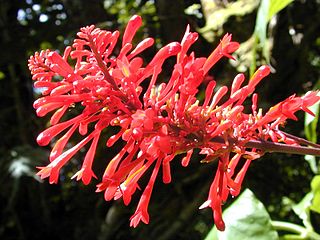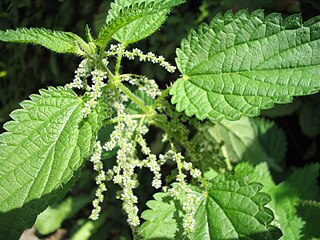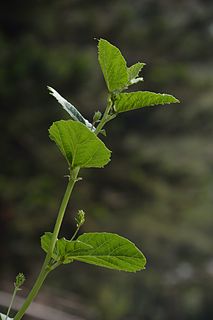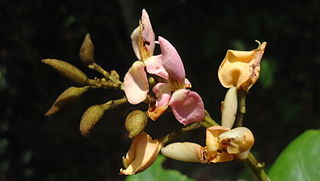
The Apiales are an order of flowering plants. The families are those recognized in the APG III system. This is typical of the newer classifications, though there is some slight variation and in particular, the Torriceliaceae may be divided.

The Moraceae — often called the mulberry family or fig family — are a family of flowering plants comprising about 38 genera and over 1100 species. Most are widespread in tropical and subtropical regions, less so in temperate climates; however, their distribution is cosmopolitan overall. The only synapomorphy within the Moraceae is presence of laticifers and milky sap in all parenchymatous tissues, but generally useful field characters include two carpels sometimes with one reduced, compound inconspicuous flowers, and compound fruits. The family includes well-known plants such as the fig, banyan, breadfruit, mulberry, and Osage orange. The 'flowers' of Moraceae are often pseudanthia.

Acanthaceae is a family of dicotyledonous flowering plants containing almost 250 genera and about 2500 species. Most are tropical herbs, shrubs, or twining vines; some are epiphytes. Only a few species are distributed in temperate regions. The four main centres of distribution are Indonesia and Malaysia, Africa, Brazil, and Central America. Representatives of the family can be found in nearly every habitat, including dense or open forests, scrublands, wet fields and valleys, sea coast and marine areas, swamps, and mangrove forests.
Urticales is an order of flowering plants. Before molecular phylogenetics became an important part of plant taxonomy, Urticales was recognized in many, perhaps even most, systems of plant classification, with some variations in circumscription. Among these is the Cronquist system (1981), which placed the order in the subclass Hamamelidae [sic], as comprising:

The Urticaceae are a family, the nettle family, of flowering plants. The family name comes from the genus Urtica. The Urticaceae include a number of well-known and useful plants, including nettles in the genus Urtica, ramie, māmaki, and ajlai.

Atriplex is a plant genus of 250–300 species, known by the common names of saltbush and orache. It belongs to the subfamily Chenopodioideae of the family Amaranthaceae s.l.. The genus is quite variable and widely distributed. It includes many desert and seashore plants and halophytes, as well as plants of moist environments. The generic name originated in Latin and was applied by Pliny the Elder to the edible oraches. The name saltbush derives from the fact that the plants retain salt in their leaves; they are able to grow in areas affected by soil salination.

Marsilea is a genus of approximately 65 species of aquatic ferns of the family Marsileaceae. The name honours Italian naturalist Luigi Ferdinando Marsili (1656–1730).
Thomandersia is the sole genus in the Thomandersiaceae, an African family of flowering plants. Thomandersia is a genus of shrubs and small trees, with six species native to Central and West Africa.

Blepharis is a genus of plant in family Acanthaceae. It contains around 126 species found in seasonally dry to arid habitats from Africa over Arabia to Southeast Asia. In section Acanthodium, there are 13–15 species that use the C4 carbon fixation pathway. Phylogenetic analysis suggests that this pathway evolved up to three times independently in the genus over the last five million years.
Maytenus dhofarensis is a species of plant in the family Celastraceae and is found in Oman and Yemen. It is an intricately branched spiny shrub or small tree with its leaves arranged alternately or clustered on short shoots. The flowers have white or cream petals and the fruit are purple or red. It is threatened by habitat loss.

Ruttya fruticosa, also known as jammy mouth or jêmbekkie, is a shrub which is native to Africa. It can be found in South Somalia to Tanzania and in the woodlands of Dhofar, Oman. The name Ruttya was named in honour of Dr John Rutty and fruticosa means shrubby and refers to the habit of the plant.

Psoralea corylifolia (Babchi) is a plant used in Indian and Chinese traditional medicine. The seeds of this plant contain a variety of coumarins, including psoralen.

Tetramerium is a genus of plants belonging to the family Acanthaceae. It is found mainly in the Americas, especially in tropical dry forests. Christian Gottfried Daniel Nees von Esenbeck first described the genus in 1846 after collecting two species on the journey of HMS Sulphur.

Lilioid monocots is an informal name used for a grade of five monocot orders in which the majority of species have flowers with relatively large, coloured tepals. This characteristic is similar to that found in lilies ("lily-like"). Petaloid monocots refers to the flowers having tepals which all resemble petals (petaloid). The taxonomic terms Lilianae or Liliiflorae have also been applied to this assemblage at various times. From the early nineteenth century many of the species in this group of plants were put into a very broadly defined family, Liliaceae sensu lato or s.l.. These classification systems are still found in many books and other sources. Within the monocots the Liliaceae s.l. were distinguished from the Glumaceae.

The Suaedoideae are a subfamily of plants in the family Amaranthaceae.

The tribe Exostyleae is an early-branching monophyletic clade of the flowering plant subfamily Faboideae that are mostly found in Neotropical rainforests.

The subfamily Dialioideae is one of the subdivisions of the plant family Fabaceae (legumes). This subfamily includes many tropical trees and shrubs. The subfamily consists of 17 genera, which are widespread throughout the tropics. It has the following clade-based definition:
The most inclusive crown clade containing Poeppigia proceraC.Presland Dialium guianense(Aubl.) Sandwith, but not Cercis canadensisL., Duparquetia orchidaceaBaill., or Bobgunnia fistuloides(Harms) J. H. Kirkbr. & Wiersema

Yeatesia is a putative genus of flowering plants in the family Acanthaceae, found in northeast Mexico and the southeast United States, from Texas to Florida. Each of its species grows in very different habitats; Yeatesia mabryi is found in hardwood forests in Mexico, Y. platystegia prefers semiarid scrublands in Mexico and Texas, and Y. viridiflora grows in wetter forest bluffs and along water courses in US Gulf Coast states. Molecular evidence shows that Yeatesia is not a monophyletic genus.
Sphinctacanthus is a genus of flowering plants in the family Acanthaceae, native to Myanmar and Sumatra. Poorly attested, it seems to be found in tropical evergreen forests.















